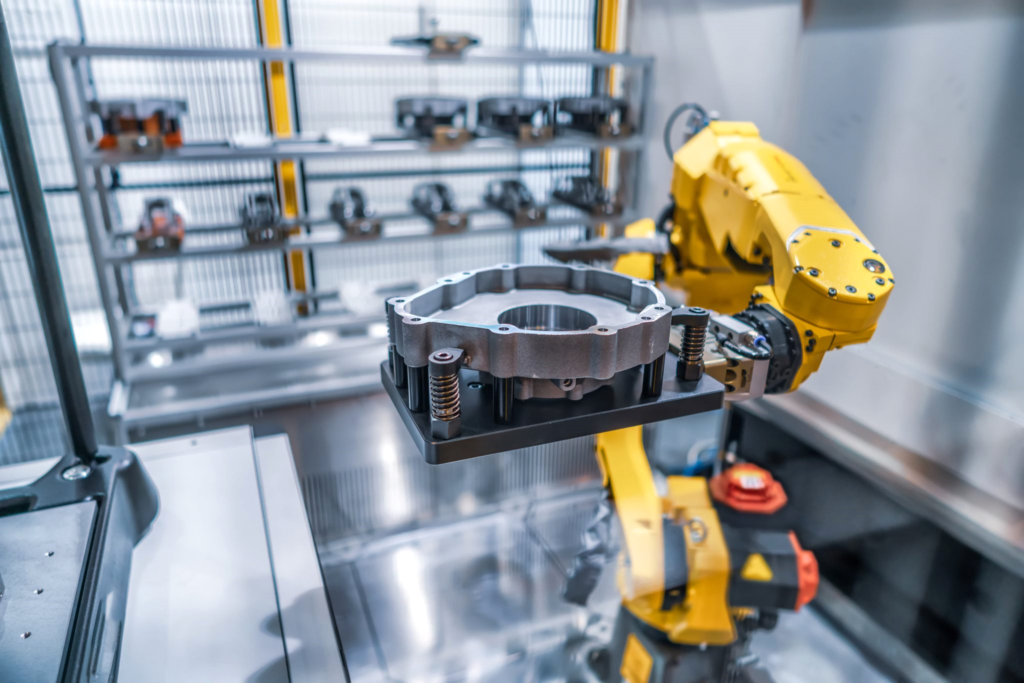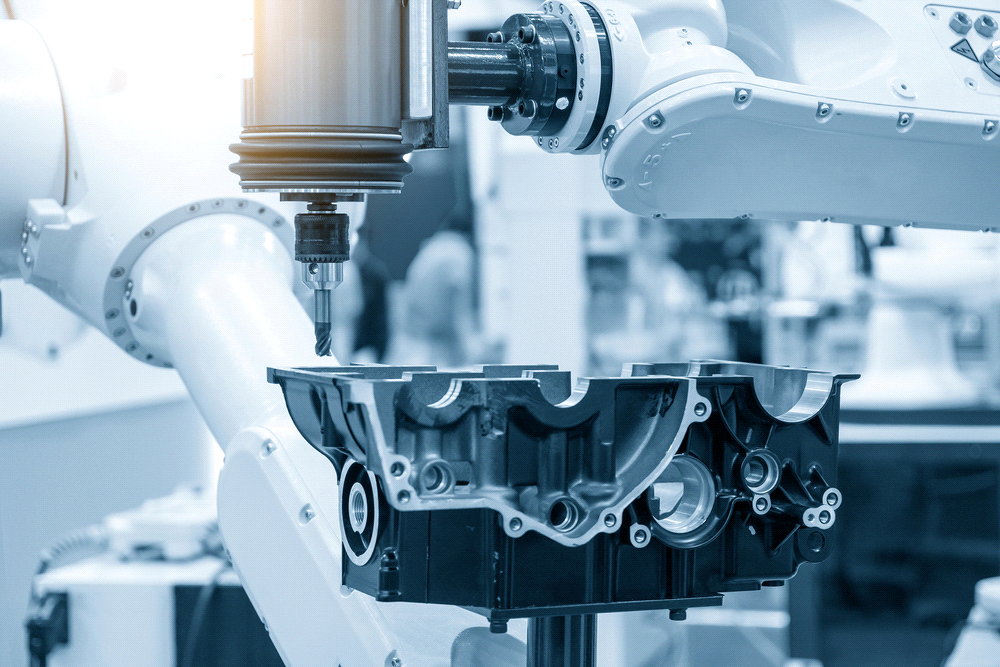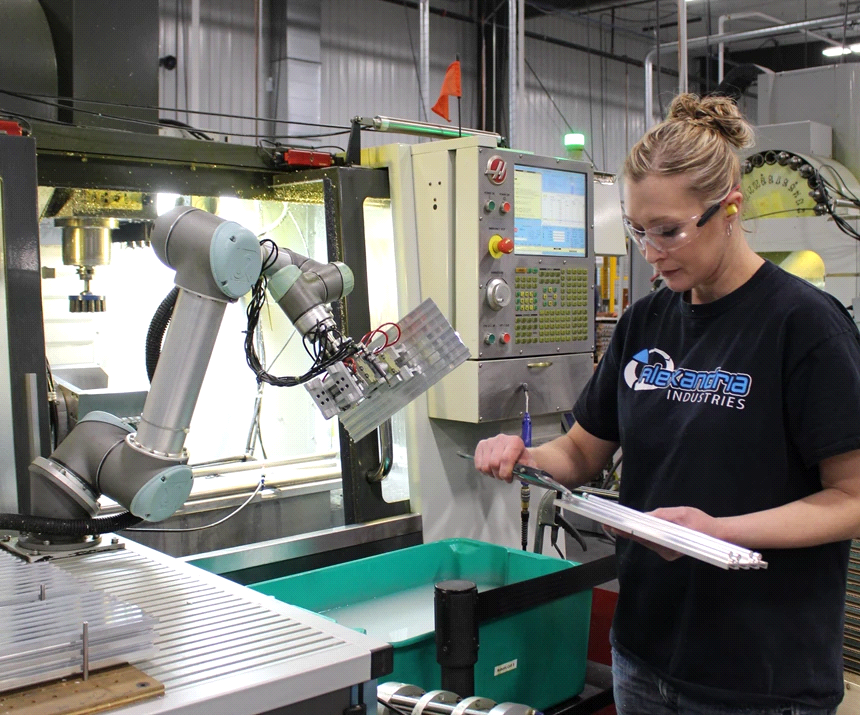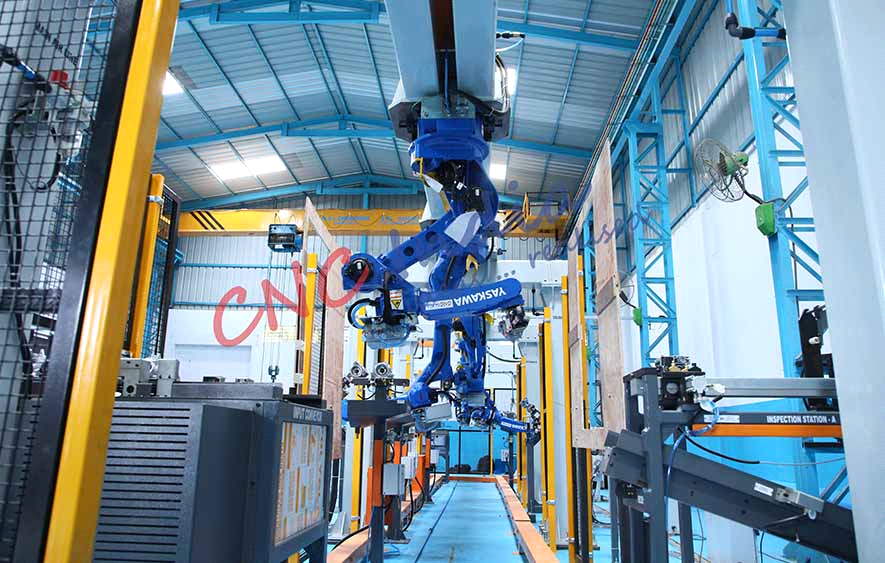Introduction
The field of computer numerical control (CNC) robotics and automated machining has advanced greatly in recent years. The adoption of robots into manufacturing technologies is a major reason for the current state of robotics’ success. CNC machining has emerged as a leading technology.
There is some overlap between CNC machining and robotic machining, although the distinction is becoming increasingly vague. The manufacturing sector can reap enormous benefits from integrating robotics. In addition, computer numerical control (CNC) manufacturing robots are the go-to for automated solutions in the manufacturing sector.
With tolerances as close as 4μm, CNC machines are exact and precise. They play a crucial role in the robotics sector, which has strict criteria for the accuracy and precision of machined parts, thanks to these capabilities. Additionally, CNC machining has quick turn-around rates, enabling you to produce a finished product in a matter of hours as opposed to days or even weeks with conventional machining.

What is CNC robotics?
When talking about robotic processes that help with computer numerical control machining (CNC), the term “CNC robotics” is used. A computer-numerically controlled robot is any high-tech machine made specifically for fabricating. Such machinery autonomously completes a variety of tasks based on predefined instructions. These robots can function autonomously in most situations.
As a result of the greater automation afforded by CNC robotics, manufacturers can reliably produce and ship large quantities of high-quality components to a wide range of industries. Robotic integration with these CNC machines is useful, but CNC machining is also used to make components for other robots.
Why choose CNC machining for producing robotic parts?
CNC machining for specialized robotic applications has many advantages, including cost savings. This list includes the following:
Increased Speed
It’s common knowledge that CNC machining may reduce production timelines for many parts. Cutting-edge computer numerical control machines (CNCs) can speed up production times compared to many conventional methods. This ensures quick iterations and prompt delivery of specialized robotic components for a wide range of uses. Robot parts can be made using CNC machining in as little as one to three days, depending on their size and complexity.
Dimensional Accuracy
Parts made using CNC machining can be manufactured to the most minute detail. Precision in manufacturing is especially important in the field of robotics, as it is essential to achieve close tolerances while designing effective robots. Tolerances as small as +/- 0.0002 inches are possible with CNC precision machining. So it can make parts for robots that can move in precise, repetitive ways.
Compatibility of Materials
CNC machining may be used with a variety of metals and plastics, which is a huge boon in the robotics industry. In order to safely lift and transport goods, robot components need to move smoothly. That’s why they need materials that are both robust and rigid, with a high strength-to-weight ratio. In order to make CNC components for the robotics sector, these materials must be compatible with CNC machines.
Surface Finish
The surface finish of robotic end parts can be managed via CNC machining. Surface roughness of Ra 0.8 m or less is essential for frictionless interaction between robot parts; CNC machines can assist produce such components. It is possible to improve the performance of components made with this method by performing additional surface finishing procedures on them after they have been manufactured.

CNC Machining and robotics industry
It has already been shown that the use of robots and computer numerical control (CNC) machining share similar implementations. Using CNC components in your robotics applications is a smart move, considering how much automation helps when building things.
Common CNC Robotic Parts Made with CNC Machining
CNC Robotic Arm
These are the most important components of mechanical arms that mimic the human arm. Originally developed for use in die-casting automation, CNC robot arms can today be found in a wide variety of devices across industries. Because their primary function is transport, they are typically constructed from robust materials like steel, aluminum, and certain polymers.
End Effector
The end effectors of robotic arms are the tools that the robot uses to manipulate and grasp objects. Grippers, grabbers, suction pumps, and vacuums are all examples of this versatile tool. Regardless of whether they are designed to be useful or not, they are all manufactured using CNC machines.
Specialized Fixtures and Jigs
Because of the need to secure parts while robots work on them, custom jigs and fittings are a common requirement for robot operations. Workpieces can be positioned reliably and consistently with the use of fixtures. CNC machining is the most efficient method for producing these unique parts at a reasonable price.
Sensors and Controllers
The sensors and controls in robots and automation devices are the brains of the operation. Printed circuit boards (PCBs) are an integral part of the functionality of these parts. Traditionally, chemical etching was the go-to method for making printed circuit boards (PCBs), but the difficulties inherent in this process are now entirely avoided thanks to CNC machining. By contrast to chemical etching, the CNC machining method can make these parts to exact specifications without the use of any potentially dangerous solvents.
Common Robotics Used in CNC Machining
Articulated Robots
These robots are the most prevalent in manufacturing. Axes are the common name for the rotational joints found in them. Articulated robots range from modest 2-axis designs to complicated 10-axis designs. These robots’ ability to move independently is guaranteed by the fact that each robotic axis provides a separate degree of freedom.
Due to their increased mobility and adaptability, articulated robots are well-suited for manipulating a wide range of workpieces of varying shapes and sizes. Some common uses for such robots include:
Arc welding
Material Handling
Part transfer and packaging
Assembly
Machine loading
SCARA Robots
Selective Compliance Articulated Robot Arm (SCARA) is capable of doing fast, repetitive tasks. To put it simply, these robot arms are like human ones, just faster and more precise. The small size of their bases also allows them to carry moderate loads.
In addition to assuring the well-being of employees and reducing expenses, their promptness and effectiveness also boost productivity. Common applications of SCARA robots include:
Assembly operations
Pick and place
Machining
Packaging
Inspections
Deltas Robotic
These industrial robots are parallel types utilized in high-speed manufacturing operations. Their shoes are triangular on the bottom and pointy on top, hence the name. They are commonly installed atop conveyors that carry products along assembly lines.
The configuration and mechanical design of delta robots are what set them apart from their competitors. Delta robots’ strengths are widely utilized in a variety of common contexts, including:
Assembly
Disassembly
Packaging
Pick and place
Sorting
Gantry or Cartesian Robots
The Cartesian coordinate system (X, Y, and Z) is used by these linear industrial robots to move along three axes. Because of their adaptability, gantry robots are frequently chosen. The robot’s accuracy, size, speed, and stroke length are all simply modifiable.
The range and payload of Cartesian robots are greater than those of their hexapod counterparts. Therefore, they are appropriate for use with heavier-than-usual workpieces. They can be used in a variety of contexts, including:
Assembly
Loading and unloading
Material Handling
Pick and place systems
Fastening and screw driving
Packaging
Cutting – Laser & Water-jet

Difference between CNC Robotics and CNC machines
Different from one another in quality and performance, these two technologies also differ in the operations they can accomplish. Let’s compare and contrast five key aspects to help us decide:
Accuracy
If you want to know how well a machine performs, one of the most important characteristics to look at is how precisely it can machine. Industrial robots now have an accuracy of 0.1 to 0.2 mm thanks to advancements in technology over the past several years.
In contrast, the accuracy of modern CNC machines can be as high as 0.02-0.05 mm. A Swiss lathe can produce a part with an accuracy of +/- 0.0002 mm. Because robot precision is so dependent on calibration, the robotics industry places a premium on reproducibility.
Versatility
Flexibility is a key benefit of robots. They make it simple to switch gears and handle multiple responsibilities at once. CNC robotics can do any and all of the machining processes that conventional CNC machines can.
These robots are able to navigate a variety of difficult routes. In many cases, three or four degrees of freedom on a CNC machine is sufficient for the machining task at hand. It has the potential to be limiting, though. Industrial robots can help, as some of them have more than six degrees of freedom. This allows you to machine almost any form you can imagine.
Rigidity
Precision is typically compromised by the stiffness of machine tools. Inaccurate cuts are made by tools that flex when they contact tough materials. Robots’ stiffness is less than 1 Newton per micrometer, making them less rigid than conventional CNC machine tools. However, CNC equipment is so stiff that its rigidity is measured in excess of 50 Newtons per micrometer.
Robotic machining is particularly well-suited to working with pliable materials like plastic and wood. Steel and aluminum are no problem, but there’s a chance the motors will backfire. The resulting part could suffer in precision as a result.
Workspace
CNC robots typically have a bigger workspace than CNC machines, but some CNC machines can be rather large. Typically, the working volumes of medium-sized industrial robots can reach up to 7 cubic metres. As an added bonus, robots can have their working spaces expanded by simply attaching an external axis.
Affordability
There is a price tag associated with using either robots or computer numerical control devices. However, robots have several advantages over conventional machine tools, including greater adaptability and more room for work. They’re versatile enough to perform a wide range of tasks on a wide variety of items. Therefore, they provide increased benefits at reduced expense.
Can CNC robotics replace CNC machines?
CNC manufacturing robots, in all their forms, have not been able to match the precision and speed of modern CNC machines. Because of their adaptability, robots can serve many purposes. However, computer numerically controlled machines are more suited for producing niche components.
To add insult to injury, CNC milling machines and Swiss lathe machining systems offer superior speed and accuracy that robots simply can’t match just yet. Their lack of rigidity or stiffness is a significant drawback because it limits how precisely they can work with tough substances.
Despite their rising popularity, CNC robotics may never be able to totally supplant CNC machines. Many businesses, however, are now utilizing a hybrid approach, which allows for the two systems to coexist peacefully and even boost output. CNC machines do routine machining processes while robots undertake complicated automation.

Advantages of using the robotic arm as a CNC operator
More and more businesses are using robotic automation to supplement CNC machines like lathes, mills, and plasma cutters in order to improve the CNC machining process and boost productivity. Robotic automation in a computer numerically controlled (CNC) shop has many advantages, whether applied to a single production cell or the entire facility.
Improved Productivity and Efficiency
Robots have the potential to increase productivity by 47% per hour compared to conventional methods of cutting, grinding, and milling. There are several ways in which a CNC shop may be improved, but one of the most fruitful is through the addition of robotic automation.
Robots can work without stopping for hours on end, and they don’t need breaks or lunch. Easy loading and unloading of components reduce downtime by eliminating the need for constant servicing.
In many cases, current free-standing robotic CNC machine tenders can process a wider range of component sizes, IDs, and ODs than human labor. Non-programmers may easily use the robots thanks to their menu-driven, touch-screen HMIs.
It has been proven that robots can cut 25% of cycle time using custom automation solutions. It takes very little time to switch tasks when using robotic work cells. Time savings like these allow businesses to better meet the needs of their customers and to produce small batches in a cost-effective manner.
Improved Labor Safety and Security
There are a variety of safeguards built into robots that guarantee workers’ protection as they carry out essential duties. The use of robots in certain operations also frees people to focus on more intellectually stimulating endeavors.
If money is tight, you might keep an eye out for bids on specific types of autonomous robotic CNC machines. These bids have low upfront costs, are user-friendly, and don’t need any expert maintenance or management.
Reduced Expenditures
When robotic automation is used, deployment times are often quite short and highly effective. This aids in keeping integration costs to a minimum.
Self-contained robotic CNC machine tenders might be a lifesaver for businesses on a restricted budget. Machine tenders have a cheap initial cost, allowing factories to see a quick return on investment (ROI) without sacrificing output.
The tenders themselves require no expert assistance for setup or operation. Additionally, tenders may be quickly deployed and re-deployed due to the ease with which they can be programmed.
Simplistic Installation / Robust multitasking
It is possible for non-technical people to set up a robotic CNC machine tender. The tender is simply placed in front of the CNC machines, secured to the floor, and wired for power and Ethernet. In most cases, simpler installation and operation tutorials are available to aid businesses in getting things set up with minimum fuss.
Robots can repair multiple machine components at once, which is impossible with human labor. A robot may be readily programmed to put a workpiece into a machine, and then during the machining process, it can be programmed to load yet another machine. Since both steps may be completed simultaneously, this method is also efficient.
Improved Flexibility and Insourcing Efficiency
Sometimes businesses get odd requests for work or components with variable requirements. This can be difficult, but with a robotic automation system in place, you need merely retrain the robots and adjust the equipment to meet the new requirements.
Automated cells are small in footprint yet have a massive output capacity. Because of their multitasking abilities, they are able to raise output and efficiency even further. As a result of this enhanced output capacity, CNC shops are able to rely less on outsourcing and, in some situations, even bring previously outsourced production jobs back in-house.
Better Contract Pricing
Robots in CNC factories maintain uniformity in production. This has led to better contract pricing as businesses are able to better anticipate production times and costs.
With the help of robots, annual production contract expenses are now lower than before, which has encouraged an increase in customers interested in such deals.

Summary
In the field of manufacturing, computer numerical control (CNC) robotics is the best example of cutting-edge technology. Combining CNC machines and robots helps produce remarkable results in the fabrication of parts. In the same way that CNC machines contribute to the manufacturing of robots for your applications, the combination of these two technologies also contributes to this. There are benefits to both technologies, as well as many ways they are comparable to one another and diverge from one another, but when combined, they give exceptional results.


